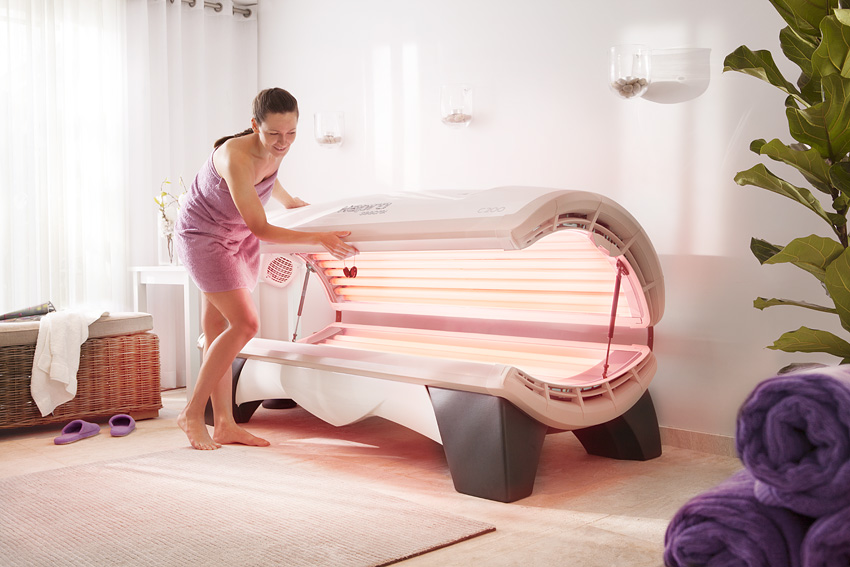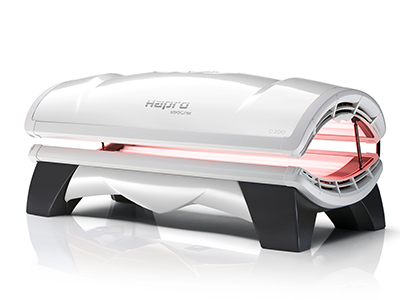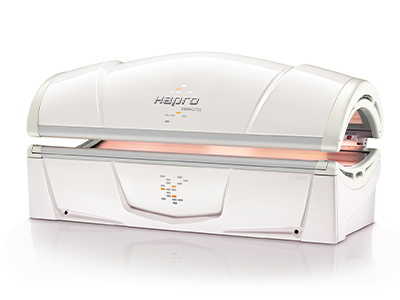LED/Light Therapy – What is it? How does it work? And WHAT do the clinical studies say about it?
Posted by Andrea Taylor on 23rd Jan 2020
The terms LED and light therapy are used as interchangeable terms and mean the same thing. Although technically "LED stands for Light Emitting Diode, which is a computer chip encased in a glass-like resin, which emits therapeutic wavelengths (or colours) of light energy,". Whereas light therapy can also be available in globes or tubes that emit therapeutic wavelengths of light.
NASA originally developed LED/Light therapy for plant growth experiments on shuttle missions and later found it to have promise for wound treatment. The U.S. Navy SEALs began using it in the 1990s to help heal wounds quickly and to help regenerate damaged muscle tissues. LED light therapy is now used to help regenerate the skin from aging and has proven successful in the treatment of mild to moderate acne.
So red light therapy, blue light therapy, collagen light therapy - what is the difference?
The terms red light therapy and collagen therapy are interchangeable and mean the same thing. Red light has a wavelength of 700–635 nm nanometers. The nanometer is a unit of distance in the metric scale and is abbreviated as nm. One nanometer (nm) equals one thousand millionths of a meter (m) or 1 nm = 10-9 m.

So how does this work?
The cells in the dermis layer of skin will convert that light energy into ATP (adenosine triphosphate), which is the fuel that the cell uses to do its job. The fibroblast cells in the dermis layer have the job of producing collagen (which gives the skin fullness or that plumped look) and elastin (which gives the skin the ability to bounce back). At around the age of 30 this process in the body begins to slow down and thus fine lines and wrinkles start to become noticeable. The stimulated fibroblasts cells produce collagen and elastin. It is like rewinding back to being 25 years old again. Red Light is also thought to reduce inflammation while improving circulation, which can give you a healthier glow.
Numerous studies have been conducted assessing the effectiveness of light therapy with clinical studies producing similar results as found by Baez et al.,The majority of subjects displayed “moderate” (50%) or “slight” (25%) response to treatment at investigator assessment. Treatment of the periorbital region was reported more effective than the nasolabial region. At 12‐week follow‐up, 91% of subjects reported improved skin tone, and 82% reported enhanced smoothness of skin in the treatment area.

Hapro Seecret® C200

Hapro Seecret® C300
Blue Light therapy, targets the sebaceous glands, which are also called oil glands. They’re located beneath your hair follicles. Sebaceous glands are necessary for lubricating your skin and hair so that it doesn’t dry out. However, these glands can become overactive, leading to oily skin and acne. The theory is that blue light therapy can target these oil glands and make them less active. In turn, you may see fewer acne breakouts. Blue light can also kill acne-causing bacteria beneath the skin, which can help treat severe acne pimples, including cysts and nodules. Blue light has a wavelength of 500–440 nm.
Oftentimes, blue light is used in conjunction with red LED light to:
- help treat acne
- decrease scarring
- promote anti-inflammatory effects
One 2018 animal study found that blue LED improved healing of third-degree skin burns.
Clinical trials have proven the effectiveness of light therapy and in particular red light therapy/collagen therapy. More recently clinical studies have found blue light therapy is very successful in treating Acne. Elmin et al found that 85% of patients demonstrate a significant quantitative reduction in at least 50% of the lesions after four biweekly treatments. In approximately 20% of the cases, acne eradication may reach 90%. At 3 months after the last treatment, clearance is approximately 70% to 80%.
Elmin et al., concluded light-based therapy is a safe and effective modality for the treatment of mild to moderate inflammatory acne vulgaris. Amelioration of acne by light therapy, although comparable to the effects of oral antibiotics, offers faster resolution and fewer side effects and leads to patient satisfaction.
References
STYLE 13/05/2016 11:03 AM AEST | Updated 15/07/2016 12:52 PM AEST. Exactly What LED Light Therapy Is And Why It's Good For Your Skin.By Leigh Campbell.
Elman M1, Lebzelter J. Surg. 2004 Feb;30(2 Pt 1):139-46.Light therapy in the treatment of acne vulgaris.
Fabien Baez,,Laurence reilly. Journal of Cosmetic Dermalotogy.The use of light‐emitting diode therapy in the treatment of photoaged skin.
.A. Morton, R.‐M. Szeimies, N. Basset‐Séguin, P.G. Calzavara‐Pinton, Y. Gilaberte, M. Hædersdal, G.F.L. Hofbauer, R.E. Hunger, S. Karrer, S. Piaserico, C. Ulrich, A.‐M. Wennberg and L.R. Braathen, European Dermatology Forum guidelines on topical photodynamic therapy 2019 Part 2: emerging indications – field cancerization, photorejuvenation and inflammatory/infective dermatoses, Journal of the European Academy of Dermatology and Venereology, 34, 1, (17-29), (2019).
Mohammad‐Ali Yazdani Abyaneh, Robert D. Griffith, Leyre Falto‐Aizpurua, Harleen Arora and Keyvan Nouri, Lasers for Acne, Pediatric Dermatologic Surgery, (207-221), (2019).
Stefano Maria Serini, Maria Vittoria Cannizzaro, Annunziata Dattola, Virginia Garofalo, Esther Del Duca, Alessandra Ventura, Massimo Milani, Elena Campione and Luca Bianchi, The efficacy and tolerability of 5‐aminolevulinic acid 5% thermosetting gel photodynamic therapy (PDT) in the treatment of mild‐to‐moderate acne vulgaris. A two‐center, prospective assessor‐blinded, proof‐of‐concept study, Journal of Cosmetic Dermatology, 18, 1, (156-162), (2018).
Seulgi Bae and Taeho Oh, In vitro bactericidal activity of 465–470 nm blue light phototherapy and aminolevulinic acid on Staphylococcus pseudintermedius, Veterinary Dermatology, 29, 4, (296-e102), (2018).
Hyuck Hoon Kwon, Sun Chul Choi, Jae Yoon Jung, You In Bae and Gyeong‐Hun Park, Comparison of novel dual mode vs conventional single pass of a 1450‐nm diode laser in the treatment of acne vulgaris for Korean patients: A 20‐week prospective, randomized, split‐face study, Journal of Cosmetic Dermatology, 17, 6, (1063-1068), (2018).
Andreas Nikolis, Stéphane Fauverghe, Giovanni Scapagnini, Dimitrios Sotiriadis, George Kontochristopoulos, Athanasios Petridis, Dimitrios Rigopoulos, Clio Dessinioti, Konstantinos Kalokasidis and Christina Antoniou, An extension of a multicenter, randomized, split‐face clinical trial evaluating the efficacy and safety of chromophore gel‐assisted blue light phototherapy for the treatment of acne, International Journal of Dermatology, 57, 1, (94-103), (2017).
Yongmin Jeon, Hye‐Ryung Choi, Myungsub Lim, Seungyeop Choi, Hyuncheol Kim, Jeong Hyun Kwon, Kyoung‐Chan Park and Kyung Cheol Choi, A Wearable Photobiomodulation Patch Using a Flexible Red‐Wavelength OLED and Its In Vitro Differential Cell Proliferation Effects, Advanced Materials Technologies, 3, 5, (2018).
Loyanne C.B. Ramos, Juliana C. Biazzotto, Juliana A. Uzuelli, Renata G. Lima and Roberto S. Silva, Ruthenium Complexes as NO Donors, Ruthenium Complexes, (257-270), (2017).
Li‐Hong Liu, Xin Fan, Yu‐Xi An, Jin Zhang, Cong‐Min Wang and Rong‐Ya Yang, Randomized trial of three phototherapy methods for the treatment of acne vulgaris in Chinese patients, Photodermatology, Photoimmunology & Photomedicine, 30, 5, (246-253), (2014).
DALIA SHAABAN, ZEINAB ABDEL‐SAMAD and MOHAMED EL‐KHALAWANY, Photodynamic therapy with intralesional 5‐aminolevulinic acid and intense pulsed light versus intense pulsed light alone in the treatment of acne vulgaris: a comparative study, Dermatologic Therapy, 25, 1, (86-91), (2012).
Michael P. McLeod, Katlein França, Keyvan Nouri and Mohamed L. Elsaie, Laser Treatment for Acne, Dermatologic Surgery, (333-336), (2012).
CHI K. YEUNG, SAMANTHA Y. SHEK, CAROL S. YU, TARO KONO and HENRY H. CHAN, Liposome‐Encapsulated 0.5% 5‐Aminolevulinic Acid with Intense Pulsed Light for the Treatment of Inflammatory Facial Acne: A Pilot Study, Dermatologic Surgery, 37, 4, (450-459), (2011).
Myoung‐Soon CHOI, Sook Jung YUN, Hee Ju BEOM, Hyoung Ryun PARK and Jee‐Bum LEE, Comparative study of the bactericidal effects of 5‐aminolevulinic acid with blue and red light on Propionibacterium acnes, The Journal of Dermatology, 38, 7, (661-666), (2010).
SEIJI KAWANA, RIEKO TACHIHARA, TOKUE KATO and TOKUYA OMI, Effect of Smooth Pulsed Light at 400 to 700 and 870 to 1,200 nm for Acne Vulgaris in Asian Skin, Dermatologic Surgery, 36, 1, (52-57), (2009).
J De Leeuw, N Van Der Beek, P Bjerring and HA Martino Neumann, Photodynamic therapy of acne vulgaris using 5‐aminolevulinic acid 0.5% liposomal spray and intense pulsed light in combination with topical keratolytic agents, Journal of the European Academy of Dermatology and Venereology, 24, 4, (460-469), (2009).
Reiko Noborio, Emi Nishida and Akimichi Morita, Clinical effect of low‐energy double‐pass 1450 nm laser treatment for acne in Asians, Photodermatology, Photoimmunology & Photomedicine, 25, 1, (3-7), (2009).
SANG HO OH, DONG JIN RYU, EUN CHUN HAN, KWANG HOON LEE and JU HEE LEE, A Comparative Study of Topical 5‐Aminolevulinic Acid Incubation Times in Photodynamic Therapy with Intense Pulsed Light for the Treatment of Inflammatory Acne, Dermatologic Surgery, 35, 12, (1918-1926), (2009).
CHI K. YEUNG, SAMANTHA Y. SHEK, CAROL S. YU, TARO KONO and HENRY H. CHAN, Treatment of Inflammatory Facial Acne with 1,450‐nm Diode Laser in Type IV to V Asian Skin Using an Optimal Combination of Laser Parameters, Dermatologic Surgery, 35, 4, (593-600), (2009).
Eric F. Bernstein, Double‐pass, low‐fluence laser treatment using a large spot‐size 1,450 nm laser improves acne, Lasers in Surgery and Medicine, 41, 2, (116-121), (2009).
Cristina Zane, Rossana Capezzera, Alessandra Pedretti, Elena Facchinetti and Piergiacomo Calzavara‐Pinton, Non‐invasive diagnostic evaluation of phototherapeutic effects of red light phototherapy of acne vulgaris, Photodermatology, Photoimmunology & Photomedicine, 24, 5, (244-248), (2008).
JUNG IM NA and DAE HUN SUH, Red Light Phototherapy Alone Is Effective for Acne Vulgaris: Randomized, Single‐Blinded Clinical Trial, Dermatologic Surgery, 33, 10, (1228-1233), (2007).
MELISSA A. BOGLE, JEFFREY S. DOVER, KENNETH A. ARNDT and SERGE MORDON, Evaluation of the 1,540‐nm Erbium:Glass Laser in the Treatment of Inflammatory Facial Acne, Dermatologic Surgery, 33, 7, (810-817), (2007).
Chi K. Yeung, Samantha Y. Shek, Peter Bjerring, Carol S. Yu, Taro Kono and Henry H. Chan, A Comparative study of intense pulsed light alone and its combination with photodynamic therapy for the treatment of facial acne in Asian skin, Lasers in Surgery and Medicine, 39, 1, (1-6), (2007).
Seung Yoon Lee, Chung Eui You and Mi Youn Park, Blue and red light combination LED phototherapy for acne vulgaris in patients with skin phototype IV, Lasers in Surgery and Medicine, 39, 2, (180-188), (2006).
Eric F. Bernstein, A pilot investigation comparing low‐energy, double pass 1,450 nm laser treatment of acne to conventional single‐pass, high‐energy treatment, Lasers in Surgery and Medicine, 39, 2, (193-198), (2006).
C. Hörfelt, J. Funk, M. Frohm‐Nilsson, D. Wiegleb Edström and A‐M. Wennberg, Topical methyl aminolaevulinate photodynamic therapy for treatment of facial acne vulgaris: results of a randomized, controlled study, British Journal of Dermatology, 155, 3, (608-613), (2006).
E. Victor Ross, Optical treatments for acne, Dermatologic Therapy, 18, 3, (253-266), (2005).
Nathan S. Uebelhoer and Jeffrey S. Dover, Photodynamic therapy for cosmetic applications, Dermatologic Therapy, 18, 3, (242-252), (2005).
Kavita Mariwalla and Thomas E. Rohrer, Use of lasers and light‐based therapies for treatment of acne vulgaris, Lasers in Surgery and Medicine, 37, 5, (333-342), (2005).
Keyvan Nouri and Christopher J Ballard, Lasers alleviate acne, Journal of Cosmetic Dermatology, 3, 3, (182-183), (2004).
Luiza Pitassi, Light-Emitting Diode for Acne, Scars, and Photodamaged Skin, Lasers, Lights and Other Technologies, 10.1007/978-3-319-16799-2_4, (73-87), (2018).
Sung-Jo Lee, The effect of Light Emitting Diode electric toothbrush on gingivitis: a randomized controlled trial, Journal of Dental Rehabilitation and Applied Science, 10.14368/jdras.2017.33.2.119, 33, 2, (119-126), (2017).
Luiza Pitassi, Light-Emitting Diode for Acne, Scars, and Photodamaged Skin, Lasers, Lights and Other Technologies, 10.1007/978-3-319-20251-8_4-1, (1-15), (2016).
Anna Baker, Light-emitting diode red light therapy: evidence base for aesthetic indications, Journal of Aesthetic Nursing, 10.12968/joan.2016.5.10.478, 5, 10, (478-482), (2016).
A. J. Greaves, The effects of narrowbands of visible light upon some skin disorders: a review, International Journal of Cosmetic Science, 38, 4, (325-345), (2016).
Meghan T. Hession, Alina Markova and Emmy M. Graber, A Review of Hand-Held, Home-Use Cosmetic Laser and Light Devices, Dermatologic Surgery, 10.1097/DSS.0000000000000283, 41, 3, (307-320), (2015).2014 7th Biomedical Engineering International Conference (BMEiCON) Fukuoka, Japan The 7th 2014 Biomedical Engineering International Conference IEEE , (2014). 978-1-4799-6801-5 Kwanchanok Viravaidya-Pasuwat, Chaiyong Koaykul and Sopita Wong-in Effect of light-emitting diode wavelengths on human dermal fibroblasts for phototherapy , (2014). 1 4 7017440 , 10.1109/BMEiCON.2014.7017440 http://ieeexplore.ieee.org/document/7017440/
Alexander Wunsch and Karsten Matuschka, A Controlled Trial to Determine the Efficacy of Red and Near-Infrared Light Treatment in Patient Satisfaction, Reduction of Fine Lines, Wrinkles, Skin Roughness, and Intradermal Collagen Density Increase, Photomedicine and Laser Surgery, 10.1089/pho.2013.3616, 32, 2, (93-100), (2014).
Hennes Gentil de Araújo, Patricia Froes Meyer, Mario Bernardo Filho, Éric Heleno Freire Frederico, Sebastião David dos Santos Filho and Marcus Vinicius de Mello Pinto, Effects of Light Emitting Diode in Erythrocytes, Modern Research in Inflammation, 10.4236/mri.2014.33015, 03, 03, (122-127), (2014).
Kui Young Park, Sun Young Choi, Seog Kyun Mun, Beom Joon Kim and Myeung Nam Kim, Combined treatment with 578‐/511‐nm copper bromide laser and light‐emitting diodes for post‐laser pigmentation: a report of two cases, Dermatologic Therapy, 27, 2, (121-125), (2013).
Nikele Nadur‐Andrade, Stella R. Zamuner, Elaine F. Toniolo, Carlos J. Lima, José C. Cogo and Camila S. Dale, Analgesic Effect of Light‐Emitting Diode (LED) Therapy at Wavelengths of 635 and 945 nm on Bothrops moojeni Venom‐Induced Hyperalgesia, Photochemistry and Photobiology, 90, 1, (207-213), (2013).
Sabrina Fabi, Joanna Bolton, Mitchel P. Goldman and Isabella Guiha, The Fabi–Bolton chest wrinkle scale: a pilot validation study, Journal of Cosmetic Dermatology, 11, 3, (229-234), (2012).
Yu Shun Tian, Nan‐Hyung Kim and Ai‐Young Lee, Antiphotoaging Effects of Light‐Emitting Diode Irradiation on Narrow‐Band Ultraviolet B–Exposed Cultured Human Skin Cells, Dermatologic Surgery, 38, 10, (1695-1703), (2012).
Landon Pryor, Chad R. Gordon, Edward W. Swanson, Richard G. Reish, Kelly Horton-Beeman and Steven R. Cohen, Dermaplaning, Topical Oxygen, and Photodynamic Therapy: A Systematic Review of the Literature, Aesthetic Plastic Surgery, 10.1007/s00266-011-9730-z, 35, 6, (1151-1159), (2011).
Sungkyoo Lim, Phototherapy and the benefits of LEDs, Journal of the Society for Information Display, 19, 12, (882-887), (2012).
석태식,김영철 and최소영, Inhibitory Effect of LED Light Irradiation on the Wrinkle Formation in Hairless Mouse, Journal of Investigative Cosmetology, 10.15810/jic.2010.6.4.005, 6, 4, (347-356), (2010).
D.H. McDaniel, R.A. Weiss, R.G. Geronemus, C. Mazur, S. Wilson and M.A. Weiss, Varying ratios of wavelengths in dual wavelength LED photomodulation alters gene expression profiles in human skin fibroblasts, Lasers in Surgery and Medicine, 42, 6, (540-545), (2010).
Mark S Nestor and Glynis R Ablon, Minimal recovery procedures, Aesthetic Rejuvenation Challenges and Solutions, 10.3109/9781841847184.004, (13-19), (2010).
Daniel Barolet, Charles J. Roberge, François A. Auger, Annie Boucher and Lucie Germain, Regulation of Skin Collagen Metabolism In Vitro Using a Pulsed 660nm LED Light Source: Clinical Correlation with a Single-Blinded Study, Journal of Investigative Dermatology, 10.1038/jid.2009.186, 129, 12, (2751-2759), (2009).
P. Boixeda, M. Calvo and L. Bagazgoitia, Recent Advances in Laser Therapy and Other Technologies, Actas Dermo-Sifiliográficas (English Edition), 10.1016/S1578-2190(08)70249-X, 99, 4, (262-268), (2008).
P. Boixeda, M. Calvo and L. Bagazgoitia, Recientes avances en láser y otras tecnologías, Actas Dermo-Sifiliográficas, 10.1016/S0001-7310(08)74674-X, 99, 4, (262-268), (2008).
E. Victor Ross, Nonablative laser rejuvenation in men, Dermatologic Therapy, 20, 6, (414-429), (2007).

